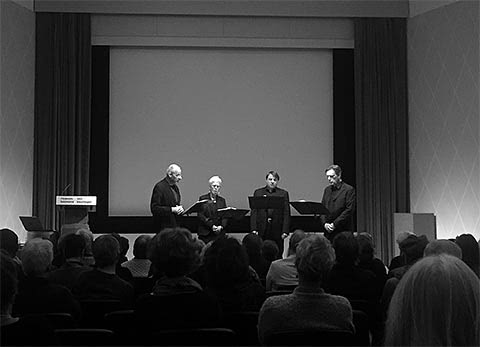On 15 January 2017 Het Retorisch Kwartet will perform a concert at Museum Boijmans Van Beuningen, inspired by the exhibition Fra Bartolommeo - the Divine Renaissance.
- Sunday, 15 January 2017, 14:00-15:00, Museum Boijmans Van Beuningen, Museumpark 18-20, 3015 CX Rotterdam

What sounds passed Fra Bartolomeo ears? What music penetrated his monastery cell? Probably not much, and certainly nothing frivolous. It is no small quest to discover what the Florentine sounds were in his time. This is not least due to the man who held Fra Bartolomeo under his influence in the last decade of the fifteenth century: Fra Girolamo Savonarola (1452-1498). This Dominican ruled the Florentine Republic from 1494 until he died at the stake. He silenced all music and merriment. For him, everything not sober and devout was mere filth: poetry, classical culture, rhetoric, humanism, music, could all literally burn on the fire.
Fra Bartolomeo’s time is no easy context to programme a concert in. We first looked for composers of vocal music who were active in the years of Fra Bartolomeo in Florence. We stumbled on a musical battle between two composers from Brabant (Flemish Brabant): Heinrich Isaac (ca. 1450-1517) and Johannes Martini (1440-1497). Isaac worked from 1480 to 1492 in Florence, in the service of Lorenzo de Medici. Isaac met Martini here, when he was on his way to Rome in 1487. What exactly happened between the two, we do not know, but Lorenzo’s 1490-91 Canzoniere (songbook) begins with nineteen pieces, alternating between Isaac and Martini, generally considered to be a composition competition. Reason enough to place the two composers at the heart of our programme.
Savonarola did not fully grasp the Florentine culture, according to a letter from Marsilio Ficino (1433 – 1499) to Antonio Canigiani, published in 1495. Ficino explains that music is in fact healthy for mind and body, invoking a series of classical thinkers. Whoever belonged to Florentine underground: the monk or the humanist? We sing humanism in any case.
Meanwhile, Costanzo Festa sang in the papal choir and composed in Rome, but visited Ferrara, where Martini worked, in 1514. This was the year he published his first known work - Quis dabit oculis, which laments the death of Anne of Brittany, Queen of France. One year later, the influential Franco-Flemish composer Adrian Willaert also started work in Ferrara. These composers’ music from Ferrara was certainly well-known in Florence.
Programme:
- Qui condolens interitu - Constanzo Festa (1490 - 1545)
- Quis dabit oculis - Constanzo Festa
- Gaudeamus omnes - Heinrich Isaac (c. 1450 - 1517)
- ’T Meisken was jonck - Heinrich Isaac
- Innsbruck, ich muss dich lassen - Heinrich Isaac
- Né più bella di queste - Heinrich Isaac
- Ave decus virginale - Johannes Martini (c. 1440 - c. 1497)
- Magnificat secundi toni - Johannes Martini
- Missa Christus Resurgens - Kyrie - Adrian Willaert (c. 1490 – 1562)
- Missa Christus Resurgens - Gloria - Willaert
- Missa Christus Resurgens - Agnus Dei - Willaert